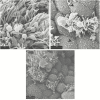Mycoplasma genitalium in Women: Current Knowledge and Research Priorities for This Recently Emerged Pathogen
- PMID: 28838078
- PMCID: PMC5853983
- DOI: 10.1093/infdis/jix198
Mycoplasma genitalium in Women: Current Knowledge and Research Priorities for This Recently Emerged Pathogen
Abstract
Health consequences of sexually transmitted diseases disproportionately affect women, making it important to determine whether newly emerged pathogens cause sequelae. Although the pathogenic role of Mycoplasma genitalium in male urethritis is clear, fewer studies have been conducted among women to determine its pathogenic role in the female reproductive tract. Pelvic inflammatory disease (PID) is an important cause of infertility and ectopic pregnancy, and Chlamydia trachomatis and Neisseria gonorrhoeae are recognized microbial causes. Emerging data demonstrate an association between M. genitalium and PID, and limited data suggest associations with infertility and preterm birth, yet the attributable risk for female genital tract infections remains to be defined. Further investigations are needed to better define the impact of M. genitalium on women's reproductive health. Importantly, prospective studies evaluating whether screening programs and targeted treatment of M. genitalium improve reproductive outcomes in women are necessary to guide public health policy for this emerging pathogen.
Keywords: Mycoplasma genitalium; cervicitis; infertility; pelvic inflammatory disease; preterm birth.
© The Author 2017. Published by Oxford University Press for the Infectious Diseases Society of America. All rights reserved. For permissions, e-mail: journals.permissions@oup.com.
Figures


References
Publication types
MeSH terms
Grants and funding
LinkOut - more resources
Full Text Sources
Other Literature Sources
Medical

